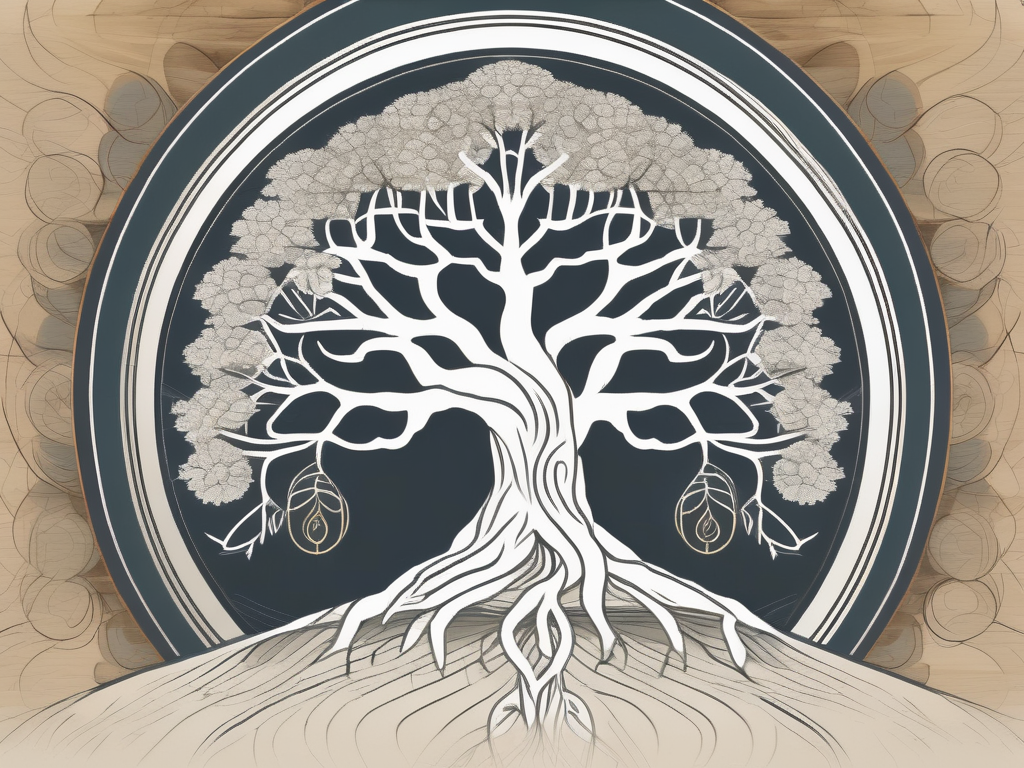In Buddhism, nirvana holds a significant place. It is the ultimate goal that practitioners strive to achieve through their spiritual journey. But what exactly is Nirvana? In this article, we will delve deep into the concept of Nirvana, its origins, its significance, and dispel any misconceptions surrounding it.
Understanding the Concept of Nirvana
To truly comprehend Nirvana, we must explore its origins in Buddhism. The word “nirvana” is derived from Sanskrit and Pali, meaning “blowing out” or “extinguishing.” However, it is not mere annihilation that Nirvana represents, but rather the extinguishing of suffering and the attainment of true enlightenment.
When we delve into the depths of Nirvana, we find a profound concept that holds immense significance in the Buddhist tradition. It is a state of being that goes beyond the limitations of our ordinary existence, offering a glimpse into the realm of ultimate liberation and transcendence.
The Origin of Nirvana in Buddhism
Nirvana finds its roots in the teachings of the Buddha. Siddhartha Gautama, the founder of Buddhism, realized that life was filled with suffering. He sought to find a way to end this suffering and ultimately discovered Nirvana as the solution.
As the Buddha embarked on his spiritual journey, he engaged in deep contemplation and meditation, seeking answers to the fundamental questions of existence. Through his profound insights and unwavering determination, he uncovered the path that leads to the cessation of suffering and the attainment of Nirvana.
Buddhist scriptures describe Nirvana as the state where one is liberated from ignorance, attachment, and delusion. It is the ultimate liberation from the cycle of rebirth and the cessation of suffering. In this state, one transcends the limitations of the ego and experiences a profound sense of freedom and peace.
Nirvana: The Ultimate Enlightenment
Nirvana is often described as the ultimate state of enlightenment. It is a state of profound wisdom, compassion, and peace. It is the complete understanding of the true nature of reality and the realization of the interconnectedness of all beings.
Attaining Nirvana is not an easy task. It requires tremendous effort, self-discipline, and a deep commitment to the Buddhist path. The journey towards Nirvana is marked by spiritual practices and the cultivation of virtues such as mindfulness, compassion, and ethical conduct.
Within the Buddhist tradition, there are various paths and practices that individuals can undertake to progress on their journey towards Nirvana. These include meditation, the study of Buddhist teachings, and the development of qualities such as loving-kindness and equanimity.
It is important to note that Nirvana is not a destination or an end point, but rather an ongoing process of transformation and awakening. As one progresses on the path, they experience glimpses of Nirvana, gradually deepening their understanding and embodying its qualities in their daily life.
Ultimately, the concept of Nirvana serves as a guiding light for Buddhists, inspiring them to cultivate wisdom, compassion, and liberation in their pursuit of true enlightenment. It is a reminder that amidst the challenges and complexities of life, there is a state of profound peace and liberation that can be attained through dedicated practice and the awakening of the mind.
The Path to Achieving Nirvana
The Four Noble Truths and the Eightfold Path are integral to the Buddhist quest for Nirvana. Let’s explore these fundamental principles in more detail.
Before delving into the depths of the Four Noble Truths, it is essential to understand their significance in the Buddhist teachings. These truths serve as the cornerstone of Buddhist philosophy, offering profound insights into the nature of existence and the path towards liberation.
The Four Noble Truths and Nirvana
The Four Noble Truths form the foundation of Buddhist teachings. They are:
- Life is characterized by suffering and dissatisfaction.
- The cause of suffering is craving and attachment.
- Suffering can be brought to an end by relinquishing attachment and desire.
- The Eightfold Path leads to the cessation of suffering.
This truth acknowledges the inherent challenges and unsatisfactory nature of human existence. It recognizes that suffering is an inevitable part of life, encompassing physical pain, emotional turmoil, and the constant yearning for something more.
Craving and attachment, fueled by ignorance and delusion, are identified as the root causes of suffering. The insatiable desire for pleasure, material possessions, and the relentless pursuit of worldly achievements perpetuate the cycle of dissatisfaction and discontentment.
This truth offers hope by suggesting that liberation from suffering is attainable. By recognizing the impermanence and transient nature of all things, one can cultivate detachment and let go of the clinging that perpetuates suffering.
The Eightfold Path, a comprehensive guide to ethical and spiritual development, provides a roadmap towards the cessation of suffering and the attainment of Nirvana. It is through the diligent practice of these interconnected principles that one can transcend the limitations of existence and achieve true liberation.
By understanding and accepting these truths, one can embark on the path towards Nirvana. The Four Noble Truths serve as a compass, guiding individuals towards a deeper understanding of their own suffering and the means to transcend it.
The Eightfold Path: A Guide to Nirvana
The Eightfold Path serves as a roadmap to achieve Nirvana. It consists of eight interconnected principles that guide individuals towards liberation:
- Right Understanding
- Right Intention
- Right Speech
- Right Action
- Right Livelihood
- Right Effort
- Right Mindfulness
- Right Concentration
Right Understanding involves developing a clear comprehension of the Four Noble Truths, the nature of reality, and the interdependent nature of all phenomena. It requires a deep exploration of the causes and conditions that give rise to suffering.
Right Intention entails cultivating wholesome intentions and aligning one’s aspirations with the principles of compassion, non-harming, and selflessness. It involves renouncing harmful desires and cultivating intentions that promote the well-being of oneself and others.
Right Speech emphasizes the importance of truthful, kind, and harmonious communication. It encourages individuals to refrain from engaging in gossip, divisive speech, harsh language, and false speech. By using words that promote understanding, harmony, and empathy, one can create a conducive environment for personal and collective growth.
Right Action encompasses ethical conduct and the practice of non-violence. It involves refraining from actions that cause harm to oneself or others, such as killing, stealing, and engaging in sexual misconduct. By cultivating integrity and acting in accordance with moral principles, one can create a foundation of trust and harmony.
Right Livelihood emphasizes the importance of engaging in a profession or occupation that is ethical and aligned with the principles of non-harming. It encourages individuals to avoid livelihoods that involve exploiting others, causing suffering, or engaging in activities that contribute to the deterioration of society and the environment.
Right Effort involves cultivating wholesome states of mind and diligently working towards the eradication of unwholesome mental states. It requires the cultivation of mindfulness, determination, and perseverance in the pursuit of spiritual growth. By exerting effort to overcome negative habits and develop positive qualities, one can gradually purify the mind and move closer to liberation.
Right Mindfulness involves the development of present-moment awareness and non-judgmental observation of one’s thoughts, feelings, and bodily sensations. It entails cultivating a deep understanding of the impermanent and ever-changing nature of existence. Through mindfulness, one can cultivate clarity, insight, and a deeper connection with the present moment.
Right Concentration refers to the cultivation of focused and one-pointed attention. It involves the practice of meditation and the development of deep states of concentration, leading to the profound insights and transformative experiences that pave the way to Nirvana. By cultivating a calm and concentrated mind, one can penetrate the nature of reality and experience the ultimate liberation.
By following this path and embodying these principles, one can gradually free themselves from suffering and move closer to Nirvana. The Eightfold Path provides a comprehensive framework for ethical conduct, mental development, and spiritual realization, guiding individuals towards the ultimate goal of liberation.
The Significance of Nirvana in Buddhism
Nirvana, the ultimate goal of Buddhism, holds immense significance within the religion. It represents the pinnacle of spiritual achievement and liberation from the endless cycle of rebirth and suffering. Let’s explore two key aspects that highlight the importance of Nirvana: Nirvana and the Cycle of Rebirth, and Nirvana as the End of Suffering.
Nirvana and the Cycle of Rebirth
In Buddhism, it is believed that individuals undergo a continuous cycle of rebirth, known as samsara. This cycle perpetuates the experience of suffering, as beings are trapped in a never-ending loop of birth, death, and rebirth. However, through the attainment of Nirvana, one breaks free from samsara and escapes the cycle of birth and death. This liberation is not merely a temporary relief but a permanent release from the cycle of suffering.
Imagine a bird trapped in a cage, unable to fly freely in the vast sky. Similarly, individuals trapped in the cycle of rebirth are confined by their own desires and attachments. However, when one attains Nirvana, it is as if the cage is opened, and the bird is set free. The individual transcends the limitations of samsara and experiences a state of boundless freedom and liberation.
Moreover, the attainment of Nirvana is not limited to a select few. It is a possibility for all individuals, regardless of their social status, gender, or background. Buddhism teaches that anyone who follows the path of enlightenment and cultivates wisdom, compassion, and moral conduct can achieve Nirvana and break free from the cycle of rebirth.
Nirvana: The End of Suffering
Central to Buddhist teachings is the recognition of suffering as an inherent aspect of existence. The Buddha taught that the root cause of suffering is attachment and desire. The constant craving for worldly pleasures and the clinging to transient phenomena lead to dissatisfaction, disappointment, and ultimately, suffering.
Through the attainment of Nirvana, one transcends suffering by emancipating themselves from these attachments. It is not a mere suppression of desires but a profound transformation of one’s perception and relationship with the world. Nirvana represents a state of complete freedom from the bondage of desire, where one finds true and lasting happiness.
Imagine a person carrying a heavy burden on their shoulders, weighed down by the worries and anxieties of life. This burden represents the suffering caused by attachment and desire. However, when one attains Nirvana, it is as if the burden is lifted, and the person is relieved from the weight of suffering. They experience a profound sense of peace, contentment, and inner harmony.
Furthermore, Nirvana is not a state of passive bliss or indifference. It is an active state of awakening and enlightenment. Those who have attained Nirvana are not detached from the world but deeply engaged in compassionate action, working for the benefit and liberation of all sentient beings.
In conclusion, Nirvana holds immense significance within Buddhism. It represents the ultimate liberation from the cycle of rebirth and the end of suffering. By attaining Nirvana, individuals break free from the perpetual cycle of birth and death, and transcend the suffering caused by attachment and desire. It is a state of profound freedom, peace, and enlightenment that is accessible to all who follow the path of wisdom, compassion, and moral conduct.
Misconceptions About Nirvana
There are several misconceptions surrounding Nirvana. It is crucial to address them to gain a clear understanding of its true nature.
Nirvana is Not a Place
Nirvana is not a physical place that one can reach or a heavenly realm. It is a state of mind and experience that can be realized within the present moment. It is an inner transformation rather than an external destination.
Nirvana is Not Annihilation
Contrary to popular belief, Nirvana is not the annihilation of the self. It is the transcendence of the ego and the realization of the interdependence of all things. Nirvana is a state of profound wisdom and compassion, where the sense of self expands to encompass the entirety of existence.
The Impact of Nirvana on Buddhist Practices
Nirvana has a profound impact on Buddhist practices as it serves as the ultimate goal and inspiration. Let’s explore two practices closely associated with Nirvana: Meditation and Ethical Conduct.
Meditation and Nirvana
Meditation plays a crucial role in the journey towards Nirvana. It serves as a means to cultivate mindfulness, concentration, and insight. Through disciplined meditation practices, individuals can quiet their minds, gain insight into the nature of reality, and ultimately experience the blissful state of Nirvana.
Ethical Conduct and Nirvana
Ethical conduct, often guided by the Five Precepts in Buddhism, is another fundamental aspect of the path towards Nirvana. Practicing ethical behavior fosters the development of morality, compassion, and mindfulness. By acting in line with these virtues, one cultivates a mind free from remorse and moves closer to the liberation of Nirvana.
In conclusion, Nirvana is the ultimate goal and realization of the Buddhist path. It represents the extinguishing of suffering, the attainment of true enlightenment, and liberation from the cycle of rebirth. By understanding the concept of Nirvana, its origins, significance, and dispelling misconceptions, one can embark on a transformative journey towards liberation and peace.












